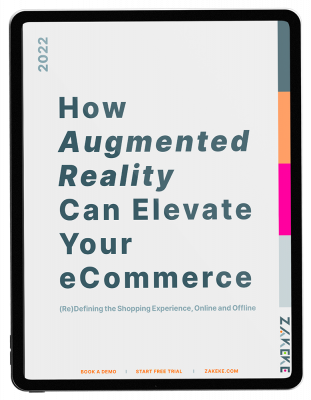Video consumption has become an integral part of our lives, and advancements in technology are revolutionizing the way we engage with video content.
Two transformative technologies, Artificial Intelligence (AI) and Augmented Reality (AR), are playing a significant role in enhancing video experiences.
In this article, we’ll explore the dynamic duo of Artificial Intelligence (AI) and Augmented Reality (AR) and how they are revolutionizing the way we watch videos. From AI’s role in video content to the interactivity of AR, we’ll delve into the exciting possibilities that these technologies bring to the table.
Augmented Reality (AR) in Video Consumption
Definition of Augmented Reality and its Application in Video Content
Augmented Reality brings a touch of magic to video consumption by overlaying digital elements onto the real world. It enhances our perception of reality and creates captivating visual experiences.
In video content, AR can add virtual objects, information, or effects that seamlessly blend with our surroundings, blurring the line between the virtual and the real.
How AR Enhances Interactivity and Viewer Engagement
AR enhances interactivity and viewer engagement in video consumption by allowing us to interact with the content directly. We can touch virtual objects, manipulate them, or explore additional information within the video environment. This level of interactivity transforms passive viewing into active participation, creating a more immersive and memorable experience.
Examples of AR Implementations in Video Consumption
Augmented Reality (AR) has revolutionized the way we consume video content by seamlessly merging the virtual and physical worlds. Through the integration of virtual elements into video experiences, AR enhances interactivity, engagement, and information sharing. Here are some fascinating examples of AR implementations in video consumption:
- Virtual Try-On Experiences: AR enables customers to virtually try on products before making a purchase. This immersive experience enhances the decision-making process and increases customer confidence;
- Interactive Product Demonstrations: AR brings products to life by overlaying digital information and animations onto physical objects. This enhances customer engagement and understanding of the product;
- AR-Enabled Storytelling: AR can be used to create interactive books or educational videos where virtual characters or objects appear and interact with the real world. This creates a captivating and educational experience for viewers, blending the virtual and physical worlds;
- AR-Driven Gaming Experiences: Games like Pokemon Go allow users to explore their surroundings and capture virtual creatures using their smartphone cameras. This fusion of the real and virtual worlds creates a unique and interactive gaming experience.
These examples showcase how AR implementations in video consumption enhance interactivity, engagement, and information sharing, transforming the way we watch and experience videos.
AR and Video in the E-commerce World
AR-Enhanced Product Pages and Virtual Try-On Experiences
In the e-commerce world, AR has become a game-changer. AR-enhanced product pages allow us to visualize products in our own environments before making a purchase. We can see how furniture fits in our living room or how a pair of sunglasses suits our faces.
Virtual try-on experiences enable us to virtually “try” clothing, accessories, or cosmetics, helping us make more confident buying decisions online.
Integration of AR in Marketing Campaigns to Enhance Customer Engagement
Marketers are harnessing the power of AR to create captivating and interactive marketing campaigns. Imagine scanning a QR code on a billboard and witnessing a virtual brand mascot come to life, or using AR to unlock exclusive content or discounts.
These innovative AR-driven campaigns engage customers on a deeper level, leaving a lasting impression and fostering brand loyalty.
Examples of Successful E-commerce Applications of AR and Video
The success stories of e-commerce applications using AR and video are inspiring. These examples demonstrate how these technologies enhance customer experiences, reduce purchase hesitation, and drive conversion rates.
By bridging the gap between physical and digital shopping, AR and video contribute to a more immersive, interactive, and convenient e-commerce environment.
Examples of Successful E-commerce Applications of AR and Video are:
- AR-Enhanced Product Pages: E-commerce websites have integrated AR technology to provide customers with a virtual try-on experience. For instance, cosmetics brands allow users to virtually try different shades of makeup using their smartphone cameras;
- Virtual Showrooms: Home furnishing companies have adopted AR technology to create virtual showrooms. Customers can use their smartphones or AR-enabled devices to visualize furniture and decor items in their own spaces before making a purchase;
- Interactive 360° Product Views: E-commerce platforms utilize interactive 360° product views to provide customers with a comprehensive understanding of products. By allowing users to rotate and zoom in on products, such as clothing or electronics, customers can examine the details and features closely;
- AR-Powered Size and Fit Assistance: Brands leverage AR to assist customers in finding the right size and fit. Users can input their body measurements or upload an image of themselves, and AR technology superimposes virtual clothing items onto their bodies, demonstrating how they would look and fit;
- AR-Enabled Instructional Videos: E-commerce platforms utilize AR in instructional videos to guide customers on product assembly, usage, or troubleshooting. By overlaying digital instructions and animations onto real-world objects, customers can follow step-by-step visual guidance for a seamless user experience;
- AR-Driven Social Commerce: Social media platforms have integrated AR features that enable users to virtually try on products shared by influencers or brands. Users can experience how makeup, accessories, or clothing would look on themselves in real-time, facilitating confident purchase decisions. This combination of AR and social media creates an engaging and interactive shopping experience.
The Rise of AI in Video Content
AI in Video Processing and Analysis
AI is a game-changer in video processing and analysis. By leveraging advanced algorithms, it improves video quality, object recognition, and content understanding. Through the power of AI, videos become sharper, more vibrant, and visually stunning.
AI’s ability to identify objects and scenes helps in categorizing and organizing video content efficiently, making it easier to search and discover videos tailored to our interests.
AI-Powered Recommendation Systems and Personalized Content Delivery
AI-powered recommendation systems have become our virtual video guides, curating personalized content for us to enjoy. These algorithms analyze our viewing history, preferences, and behavior patterns to suggest videos that align with our interests. The result? A personalized video experience that keeps us engaged and entertained for hours.
Revolutionizing Video Editing, Captioning, and Translation
A few years back, we could only use a video editor to edit, compress videos or join videos but today, AI is transforming not only video editing, but also captioning, and translation processes, making them more efficient and accessible.
Automated editing tools powered by AI algorithms enable seamless editing, saving both time and effort. AI-powered captioning and translation services make videos more accessible to a wider audience, transcending language barriers and ensuring inclusivity.
The Synergy between AI and AR in Video Experiences
How AI and AR Technologies Complement Each Other in Video Content
AI and AR technologies work in synergy, enhancing the video experience even further. AI algorithms can analyze user behavior and preferences to provide more accurate and relevant AR overlays.
This ensures that the augmented content seamlessly integrates with the real world and resonates with viewers, enhancing their overall engagement.
Integration of AI and AR in Virtual Reality (VR) Experiences
AI and AR find common ground in virtual reality experiences. By combining AI’s capabilities with AR’s immersive nature, we can create captivating and interactive virtual worlds. AI algorithms enhance AR overlays and visual recognition in VR environments, making them more realistic, responsive, and interactive.
One notable application of this integration is the creation of virtual tours. With the advent of AI and AR in VR, we can now embark on virtual tours that offer realistic and immersive experiences. Today, we can Travel to Europe or anywhere else in the world from the comfort of our own homes. AI algorithms enhance AR overlays and visual recognition in VR environments, making them more realistic, responsive, and interactive.
How AI Can Enhance AR Overlays and Visual Recognition in Videos
AI plays a vital role in enhancing AR overlays and visual recognition in videos. AI algorithms can improve object recognition accuracy, enabling more precise and seamless integration of virtual objects into the real world. Additionally, AI can enhance the visual quality of AR overlays, ensuring they blend naturally with the video content, creating a seamless and immersive experience.
Challenges and Future Implications
Challenges and Limitations of AI and AR in Video Consumption
While AI and AR bring immense potential, they also face challenges. Technical limitations, such as computational power and data requirements, need to be addressed for wider adoption.
Additionally, ensuring privacy and data protection is crucial when using AI and AR technologies in videos. Overcoming these challenges will pave the way for more widespread and responsible use of AI and AR in video consumption.
Addressing Privacy Concerns and Ethical Considerations Related to AI and AR Technologies
As AI and AR become more prevalent in video experiences, addressing privacy concerns and ethical considerations is paramount. Protecting user data and ensuring transparent and responsible use of these technologies is crucial for building trust and fostering user confidence. It is essential for stakeholders to implement robust privacy measures and ethical guidelines to safeguard user rights and privacy.
Potential Future Advancements and Applications of AI and AR in Video Experiences
The future holds exciting prospects for AI and AR in video experiences. Advancements in AI algorithms, hardware capabilities, and data availability will unlock new possibilities. We can anticipate more sophisticated AI-powered recommendation systems, enhanced AR experiences, and seamless integration of AI and AR in virtual reality environments. These advancements will reshape content creation, distribution, and consumption, offering unparalleled video experiences.
Implications of AI and AR for Content Creators, Consumers, and the Industry as a Whole
AI and AR have profound implications for content creators, consumers, and the industry. Content creators can leverage AI and AR tools to create more immersive and personalized experiences, expanding their creative boundaries.
Consumers will enjoy more engaging and tailored video content that aligns with their interests. The industry, as a whole, will witness new business opportunities, increased customer satisfaction, and the emergence of innovative video-based products and services.
Conclusion
AI and AR are revolutionizing the way we watch videos, offering immersive, personalized, and interactive experiences. From AI’s role in video processing and recommendation systems to AR’s ability to enhance interactivity and engagement, these technologies are reshaping the landscape of video consumption.
As AI and AR continue to evolve and overcome challenges, we can expect a future where video experiences become even more captivating and transformative. So, buckle up and get ready to embark on an extraordinary journey into the world of AI and AR-powered video experiences!

VEED
VEED is an online video editing platform that empowers creators to transform their videos with ease. With a team of skilled developers and video editing enthusiasts, VEED is revolutionizing the way people edit and enhance their video content. Through a user-friendly interface and a comprehensive suite of editing tools, VEED enables users to add captivating effects, captions, subtitles, and images to their videos effortlessly.















